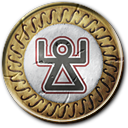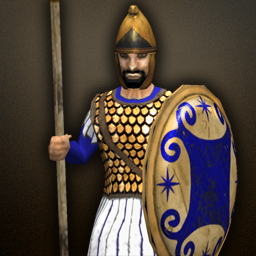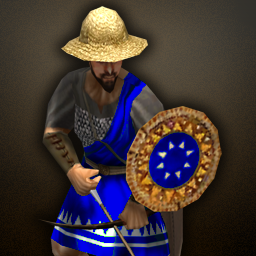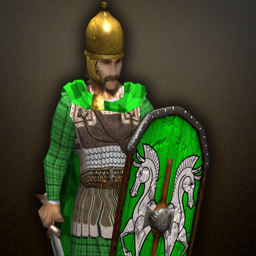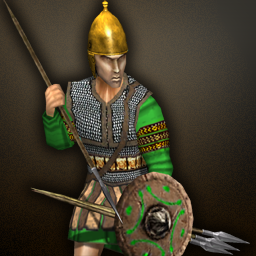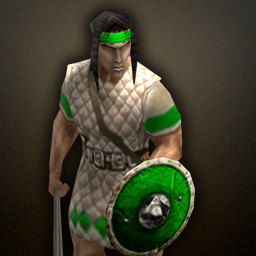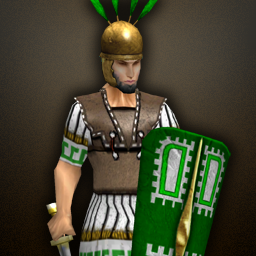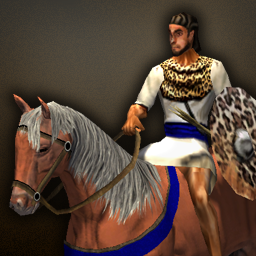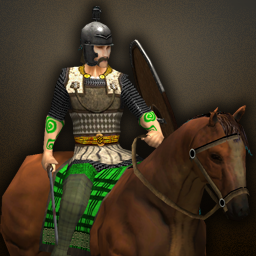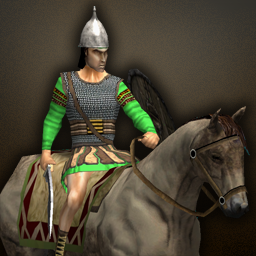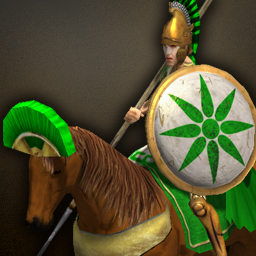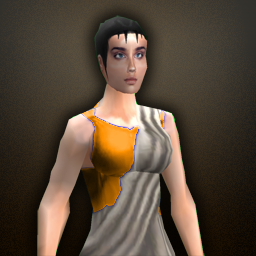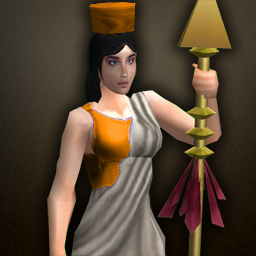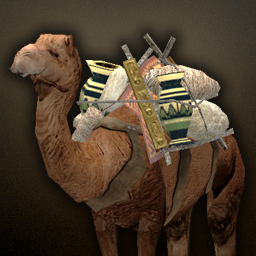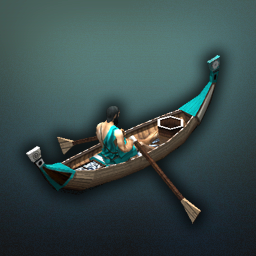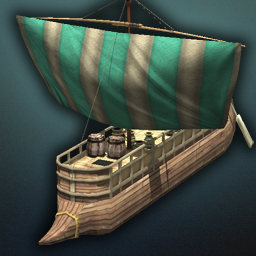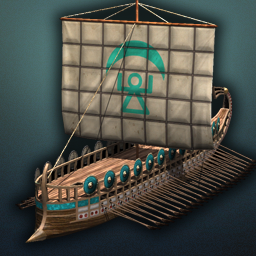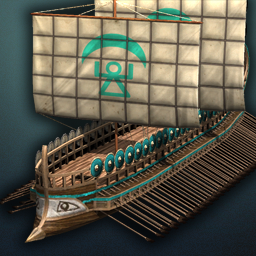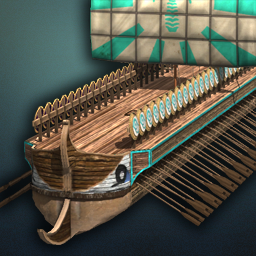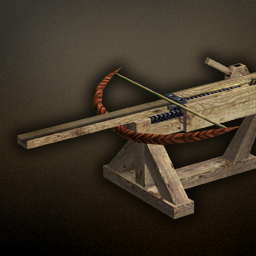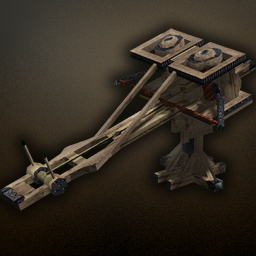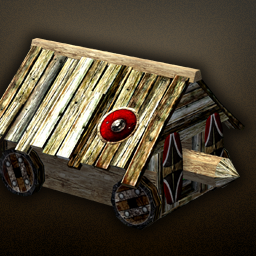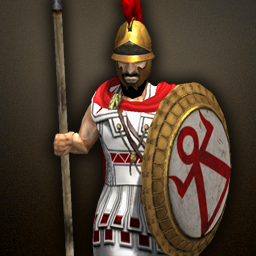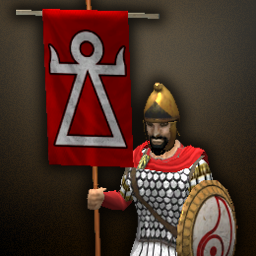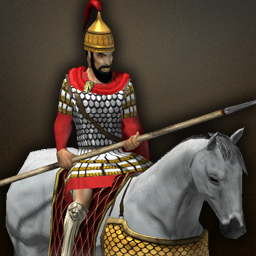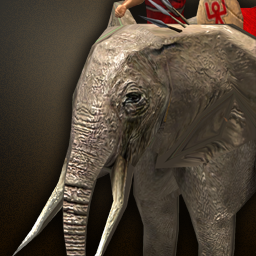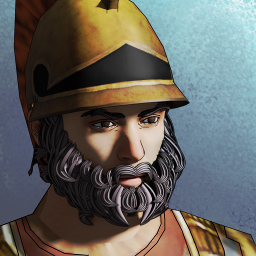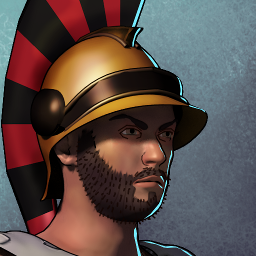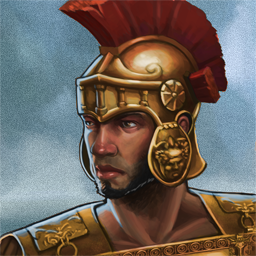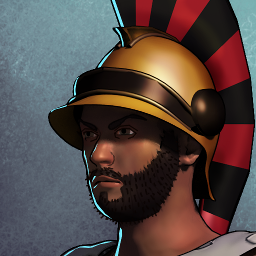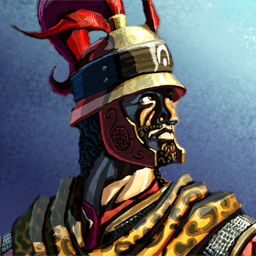OUTDATED
For the most up-to-date information, check the Civilisation Overview and Structure Tree in the game.
Table of Contents
CARTHAGINIAN CIVILISATION PROFILE
by Ken Wood [aka Phoenix-TheRealDeal / tonto_real] Email: ken@0ad.wildfiregames.com. (Arizona, United States of America). Historical consultants, translators and contributors: Professor Alejandro Carneiro [aka Piteas] (Classical & Antiquity Greco-Romano-Iberico History Studies) (Spain). Aviv Sharon [aka Jeru] (Israel). Contributing concept artists: Antonio J. Flamas [aka ajflamas] (Spain); Aviv Sharon [aka Jeru] (Israel); Jason Bishop [aka Wijitmaker] (Washington, United States of America); Marco Giannini [aka Kellian] (Italy). Revised by: Joshua Gilbert [aka Shogun144] (Michigan, United States of America) Langbart Carl Ortega [aka Carltonus] Email:carlthegreat-6996@yahoo.com (California, United States of America)
UNIT DESCRIPTIONS
INFANTRY
- Generic Name: Libyan Spearman
- Specific Name: Səḫīr Ḥanīt
- Class: Citizen Hoplite.
- Hacker Armament: Long spear (dory).
- Appearance: -
- Basic:
- Advanced:
- Elite:
- History: Although the Liby-Phoenician soldiers were not themselves citizens of the city of Carthage, they were levied to the armies of Carthage from those Phoenician colonies of modern-day Tunisia and Libya that had been taken over by the Carthaginians upon the demise of the mother cities in the Levant. Those town and cities were not permitted to hold standing armies of their own, having instead to rely upon Carthage for leadership and defense.
- Garrison: 1.
- Function: Deals triple damage against cavalry.
- Special: Trained at the standard Barracks and Civic Center. As a hoplite, may use the Phalanx formation (minimum 10 units).
- Generic Name: Mauritanian Archer
- Specific Name: Qešet
- Class: Citizen Infantry Archer.
- Hacker Armament: Bow.
- Appearance: -
- Basic:
- Advanced:
- Elite:
- History: The Mauritanians are said to have supplied good archers to the armies of Carthage. Probably kin of the Berbers. The Romans similarly hired and appreciated Mauritanian archery skills.
- Garrison: 1.
- Function: .
- Special: Trained at the standard Barracks and Civic Center.
- Generic Name: Gallic Swordsman
- Specific Name: Səḫīr Ḥerev
- Class: Mercenary Infantry Swordsman.
- Hacker Armament: Celtic Hallstatt 'La Tene' culture period long sword.
- Appearance:
Basic:- Advanced:
- Elite:
- History: Celts served as mercenaries in Carthaginian armies from the earliest times.
- Garrison: 1.
- Function: -
- Special: Trained at the Celtic Embassy.
- Generic Name: Iberian Skirmisher
- Specific Name: Səḫīr Kidōn
- Class: Mercenary Infantry Javelineer.
- Hacker Armament: Javelin.
- Appearance: -
Basic:- Advanced:
- Elite:
- History: Though initially mercenaries hired by the Carthaginians, once the Carthaginian expansion was made into large areas of the Iberian Peninsula, these soldiers became levies imposed by the Carthaginian generals on their "allies".
- Garrison: 1.
- Function: -
- Special: Trained at the Iberian Embassy.
- Generic Name: Balearic Slinger
- Specific Name: Qallāʿ Ibušimi
- Class: Mercenary Slinger.
- Ranged Armament: Three slings and sling bolt pouch.
- Appearance: -
Basic:- Advanced:
- Elite:
- History: The Balearic Slinger regiments were a levy from the islands that had been under control of Carthage from the 6th century BCE, supplying 2,000 men. They fired ceramic shot capable of punching through enemy shield and armour and dropping soldiers dead in their tracks. They carried 3 different slings of different lengths which were used to obtain range to target. Much of their skill was due to intense training since childhood.
- Garrison: 1.
- Function: .
- Special: Trained at the Iberian Embassy.
- Generic Name: Samnite Swordsman
- Specific Name: Səḫīr Romaḥ
- Class: Mercenary Infantry Swordsman.
- Hacker Armament: Xiphos.
- Appearance: -
Basic:- Advanced:
- Elite:
- History: .
- Garrison: 1.
- Function: -
- Special: Trained at the Italic Embassy.
CAVALRY
- Generic Name: Numidian Cavalry
- Specific Name: Ḥayyāl Raḫūv Masili
- Class: Citizen Cavalry Javelineer.
- Hacker Armament: Javelin.
- Appearance: -
- Basic:
- Advanced:
- Elite:
- Mount: -
- History: Numidian Cavalry were known to be the fastest, most agile, in the ancient world; the riders rode without bridle or reins, steering their mount with knee pressure and body signals alone. They were the only cavalry that the Romans were unable to adequately deal with.
- Garrison: 2.
- Function: Good skirmisher and raider.
- Special:
- Trained at the standard Barracks and Civic Center.
- Movement: Fastest cavalry unit in the game.
- Generic Name: Gallic Mercenary Cavalry
- Specific Name: Ḥayyāl Ḥerev Raḫūv
- Class: Mercenary Cavalry Swordsman.
- Hacker Armament: Celtic cavalry sword.
- Appearance: -
Basic:- Advanced:
- Elite:
- Mount: Typical head gear, 4 horned saddle, no stirrups, severed heads hanging off the saddle in Elite status.
- History: Like a sword, a horse was a sign of nobility and as a result the Gallic cavalry was often better equipped than the infantry. Armor and helmets were common, while weapons consisted of a large bladed spear and a long slashing sword for close combat. Shields could be round, hexagonal, or oval, but the most common was a regular oval body shield with the top and bottom shorn off. Unlike other horseman, the Celts were not afraid to leap off their mount to fight on foot then climb into the saddle again when possible.
- Garrison: 2.
- Function: Heavy cavalry.
- Special: Trained at the Celtic Embassy.
- Generic Name: Iberian Cavalry
- Specific Name: Ḥayyāl Kidōn Raḫūv
- Class: Mercenary Cavalry Swordsman.
- Hacker Armament: Falcata.
- Appearance: -
Basic:- Advanced:
- Elite:
- Mount:
- History: Though initially mercenaries hired by the Carthaginians, once the Carthaginian expansion was made into large areas of the Iberian Peninsula, these soldiers became levies imposed by the Carthaginian generals on their "allies".
- Garrison: 1.
- Function: -
- Special: Trained at the Iberian Embassy.
- Generic Name: Italic Cavalry
- Specific Name: Ḥayyāl Romaḥ Raḫūv
- Class: Mercenary Cavalry Spearman.
- Hacker Armament: Spear.
- Appearance: -
Basic:- Advanced:
- Elite:
- Mount: -
- History: The Italian allies of Carthage included the various Samnite tribes of the interior hill-country and Italiote Greek colonies along the Southern coast. They provided a much-needed and high-quality cavalry contingent for Hannibal's army.
- Garrison: 2.
- Function: -
- Special: Trained at the Italic Embassy.
SUPPORT UNITS
- Generic Name: Carthaginian Woman
- Specific Name: Aštāh
- Appearance:
- Garb: Grecian female dress and hair style based upon that of the Mauritanians as brought to them via the Phoenicians, thus passing through Carthage.
- History: Unlike many ancient cities, Carthage was found by a woman; Queen Dido, hailing originally from Tyre. Carthaginian women were famous for their beauty and were capable of extremely hard physical work. The records written about the Third Punic War mentioned that all citizens of Carthage, including the women, worked incessantly to manufacture weapons and prepare the city for siege. The women even cut their own hair for use in the springs of artillery pieces.
- Garrison: 1.
- Function: -
- Special: -
- Appearance:
- Generic Name: Priestess of Tanit
- Specific Name: Kehinit
- Class: Healer.
- Appearance:
- Garb: .
- Figure(s): -
- History: Tanit, chief goddess of Carthage, equivalent of Astarte. Although she seems to have had some connection with the heavens, she was also a mother goddess, and fertility symbols often accompany representations of her. She was probably the consort of Baal Hammon (or Amon), the chief god of Carthage, and was often given the attribute "face of Baal." Although Tanit did not appear at Carthage before the 5th century BC, she soon eclipsed the more established cult of Baal Hammon and, in the Carthaginian area at least, was frequently listed before him on the monuments. In the worship of Tanit and Baal Hammon, children, probably firstborn, were sacrificed. Ample evidence of the practice has been found west of Carthage in the precinct of Tanit, where a tofet (a sanctuary for the sacrifice of children) was discovered. Tanit was also worshipped on Malta, Sardinia, and in Spain. There is no other reason for giving the Carthaginians a priestess instead of a priest in 0 A.D., although Tanit was the most popular of their two main gods with the people.
- Garrison: 1.
- Function: -
- Special: -
- Generic Name: Merchant
- Specific Name: Mekir
- Appearance:
- Figure(s): See reference drawing for Merchantman for typical trader figures standing on beach in front of ship.
- Mount: Dromendary camel.
- History: While not as important as trade by sea, the Carthaginians did value trading on land.
- Garrison: 1.
- Function: -
- Special: -
- Appearance:
NAVY
- Generic Name: Fishing Boat
- Specific Name: Noon-Mašōt
- Class: Fishing Boat.
- Appearance:
- Shell: -
- Figure(s): -
- History: Fishing for the Carthaginians was much the same as it was for the Phoenicians from whom they were descended. Being primarily a sea power, fishing was one of Carthage’s primary means of food supply. The main fishing boat used was a medium sized (about 20 feet) row and sail boat.
- Garrison: 1.
- Garrison Limit: 1 (support, infantry).
- Function: Gathering is their only method of collecting.
- Special: -
- Generic Name: Merchantman
- Specific Name: Seḥer
- Class: Merchant Ship.
- Appearance:
- Shell: The drawing below is the ship that I want modeled for the Carthaginian Merchantman (skinned differently also for the Iberians).
- Figure(s): -
- History: The entire purpose of the Phoenicians/Carthaginians was to conduct trade and commerce principally upon the sea (though not limited to that as far as Carthage was concerned).
- Garrison: 1.
- Function:
- Special: -
- Generic Name: Bireme
- Specific Name: Du-Mašōt
- Class: Light Warship.
- Appearance:
- Shell: .
- Figure(s): .
- History: The Phoenicians/Carthaginians were the first to develop bireme technology by taking the pentekonter, "cutting it in half", and then stacking two rows of oarsmen tiered atop the other, producing a ship half the length that was more maneouvreable and faster in the water. The ram section at the bow was built to look like a sea monster swimming through the water in order to terrorise superstitious potential competitors. They were also fed tall tales of such denizens in a propaganda effort to mislead and frighten off others who might consider following them into unknown waters.
- Garrison: 1.
- Function:
- Special: -
- Generic Name: Trireme
- Specific Name: Tlat-Mašōt
- Class: Medium Warship.
- Appearance:
- Shell: .
- Figure(s): .
- History: Triremes were a longtime mainstay of the Phoenician/Carthaginian fleet that was the largest maintained on the Mediterranean Sea, also ranging out into the Atlantic as protection for its Merchantmen. The Athenian Greeks were the only ones to build a faster ship of this type.
- Garrison: 1.
- Function:
- Special: -
- Generic Name: Quinquereme
- Specific Name: Ḥameš-Mašōt
- Class: Heavy Warship.
- Appearance:
- Shell: .
- Figure(s): .
- History: The Carthaginians were long in the forefront of ship technology, maintaining the largest fleet in the Mediterranean for centuries. Their Quinquereme was also the best on the water and essentially unchallengeable until the Romans built a Quinquereme largely from Carthaginian design (having "captured" a grounded ship of its type) then later developed the corvus boarding ramp for it.
- Garrison: 1.
- Function: .
- Special: .
SIEGE
- Generic Name: Oxybeles
- Specific Name: .
- Class: Bolt Shooter.
- Appearance:
- Shell: .
- Figure(s): Greek oxybeles.
- History: The Carthaginians are known for having had many siege weapons.
- Garrison: 1.
- Function: -
- Special: -
- Generic Name: Ballista
- Specific Name: .
- Class: Stone Thrower.
- Appearance:
- Shell: .
- Figure(s): Roman ballista.
- History: The Carthaginians are known for having had many siege weapons.
- Garrison: 1.
- Function: -
- Special: -
- Generic Name: Battering Ram
- Specific Name: .
- Class: Ram.
- Appearance:
- Shell: .
- Figure(s): Iberian covered ram.
- History: The Carthaginians are known for having had many siege weapons.
- Garrison: 1.
- Function: -
- Special: -
CHAMPION UNITS
- Generic Name: Sacred Band Hoplite
- Specific Name: Sacred Band of Ba’al
- Class: Champion Hoplite.
- Hacker Armament: Long spear (dory).
- Appearance: -
- Garb: -
- Figure(s): -
- History: The Sacred Band represented a group of Carthaginian Citizens that had volunteered for military service. The Hellenes spoke well of this battalion for its service during the Sicilian Wars in the fourth century BC, and offered praise for their valor, courage, discipline, and the excellence of their arms and armor. The Sacred Band gained its name for its religious devotion. These men fought as hoplites in all confirmed historical occurrences of this unit.
- Garrison: 1.
- Function: Heavy spear infantry. Good for holding the main battle line. Deals triple damage against cavalry.
- Special: Trained at the Temple. As a hoplite, may use the Phalanx formation (minimum 10 units).
- Generic Name: Sacred Band Pikeman
- Specific Name: Mašal
- Class: Atlas-only Champion Hoplite.
- Hacker Armament: Pike (sarissa).
- Appearance: -
- Garb: -
- Figure(s): -
- History: The Sacred Band represented a group of Carthaginian Citizens that had volunteered for military service. The Hellenes spoke well of this battalion for its service during the Sicilian Wars in the fourth century BC, and offered praise for their valor, courage, discipline, and the excellence of their arms and armor. The Sacred Band gained its name for its religious devotion. These men fought as pikemen in all confirmed historical occurrences of this unit.
- Garrison: 1.
- Function: Deals triple damage against cavalry.
- Special:
As a pikeman, may use the Phalanx formation(minimum 16 units ,not implemented yet).
- Generic Name: Sacred Band Cavalry
- Specific Name: Sacred Band of Astarte
- Class: Champion Lancer.
- Hacker Armament: Long cavalry spear.
- Appearance:
- Garb: .
- Figure(s): .
- Mount: Horse.
- History: The Sacred Band of Astarte was an elite cavalry regiment recruited from amongst the upper class of the city.
- Garrison: 1.
- Function: Heavy Cavalry.
- Special: .
- Generic Name: North African War Elephant
- Specific Name: Pil Malḥamit
- Class: Champion Elephantry.
- Hacker Armament: Tusks.
- Ranged Armament: Javelins (ornamental).
- Appearance:
- Garb: Tunic, round wooden shield.
- Figure(s): -
- Mount: North African elephant.
- History: By far the most famous of Carthaginian weapons was the small, ugly, and now extinct, North African forest elephants. Going into battle without a war tower carrying only a driver, Carthaginian war elephants were used as terror weapons: horses could not stand their smell, inexperienced troops were frightened, and the havoc they could cause was immense. Yet by the time of the Second Punic War elephants were at the end of their time. Armies had learned the weaknesses of the giant beasts, specifically how to hamstring and confuse them. More often than not a war elephant could be just as dangerous to its own side as the enemy.
- Garrison: 1.
- Function: .
- Special: .
HEROES
- Generic Name: Hamilcar Barca
- Specific Name: Ḥimelqart Baraq
- Class: Hero Cavalry Swordsman.
- Hacker Armament: Kopis.
- Appearance:
- Garb: Crested Thracian helmet, decorated tunic, Iberian cuirass, greaves, leather boots.
- Mount: Horse.
- History: Father of Hannibal and virtual military dictator of Carthage. Hamilcar Barca was a soldier and politician who excelled along his entire career. While overshadowed by his sons, Hamilcar was great general in his own right, earning the nickname Baraq or Barca for the lightning speed of his advance.
- Garrison: 1.
- Function: Military Enhancement.
- Special:
- "Inspired Defense" gives the structure he garrisons +2 points regeneration rate.
- "Lightning General" aura.
- "Subduer of Mercenaries" aura.
- Generic Name: Hannibal Barca
- Specific Name: Ḥannibaʿal Baraq
- Class: Hero Elephantry.
- Hacker Armament: Tusks, Pike (sarissa).
- Appearance:
- Garb: Crested Thracian helmet, decorated tunic, Italic cuirass, cloak, white leather boots.
- Mount: Surus (towered Syrian war elephant, with Roman scuta around tower).
- History: Carthage's most famous son. Hannibal Barca was the eldest son of Hamilcar Barca and proved an even greater commander than his father. While he ultimately lost the Second Punic War, his victories at Trebia, Lake Trasimene, and Cannae, and the feat of crossing the Alps have secured his position as among the best tacticians and strategists in history.
- Garrison: 1.
- Function: Strategic Tactician.
- Special:
- "Inspired Defense" gives the structure he garrisons +2 points regeneration rate.
- "Tactician" aura
"Strategian" aura allows the player to see changes within the fog of war; for example, when new buildings are built, or resources used up.
- Generic Name: Maharbal
- Specific Name: Maharbaʿal
- Class: Hero Cavalry Spearman
(and Javelineer). - Hacker Armament: Cavalry Spear.
- Ranged Armament: Javelins (ornamental).
- Appearance:
- Garb: Crested Thracian helmet, tunic, leather linothorax cuirass, leopard skin cloak, bronze round pelte, greaves, sandals.
- Mount: Horse.
- History: Maharbal was Hannibal's "brash young cavalry commander" during the secondnd Punic War. He is credited with turning the wing of the legions at Cannae resulting in defeat in which 30,000 of 50,000 Romans were lost, as well as significant contributions to the winning of many other battles during the war. He is known for having said, after the battle of Cannae, "Hannibal, you know how to win the victory; just not what to do with it."
- Garrison: 1.
- Function: Cavalry Commander. Deals 1.75× damage against other cavalry.
- Special:
- "Inspired Defense" gives the structure he garrisons +2 points regeneration rate.
- "Cavalry Commander" aura.
- Class: Hero Cavalry Spearman
CATAFALQUE
- Generic Name: Hasdrubal.
- Specific Name: ʿAzrubaʿal.
- History: Not to be confused with the son(-in-law) of Hamilcar Barca, Hasdrubal the quartermaster is a commander during the second Punic War.
- Special:
- "Commander of Heavy Cavalry" - Leader of the Carthaginian heavy cavalry at Cannae, where his triple charge had devastating effects on the enemy. Melee Cavalry +1 crush, hack, pierce resistance and +10% health.
CIV CENTRE UNITS
- Melee Infantry: Libyan Spearman.
- Ranged Infantry: Mauritanian Archer.
- Cavalry: Numidian Cavalry.
FORBIDDEN CLASSES
- Cavalry Archer.
STRUCTURE DESCRIPTIONS
VILLAGE
- Generic Name: Civic Centre
- Specific Name: Merkāz
- Class: Civic Centre.
- History: Carthage!
- Generic Name: House
- Specific Name: Bet
- Class: House.
- History: Housing was generally built of ‘adobe’ or sandstone then plastered with stucco. Flat roofs predominate, few windows, arched doorways in evidence, kind of a blend of Achaemenian and Mediterranean styles with some tiled roofs. In the biggest cities, especially Carthage and such as Utica, housing was in flat-roofed structures rising as high as 6 and 7 stories (two-storied would be sufficient).
- Generic Name: Storehouse
- Specific Name: Maḥṣabah
- Class: Storehouse.
- History: Nothing really special here.
- Generic Name: Farmstead
- Specific Name: Aḥuzāh
- Class: Farmstead.
- History: Although there must have been many small farms as well, when the Carthaginians expanded into the hinterland, most farms and orchard establishments were created by the wealthy segment of society that became known as the landowners, and the resulting estates were mostly worked by ‘almost enslaved’ Liby-Phoenicians, Numidians, and whomever they could get.
- Generic Name: Field
- Specific Name: Šadd
- Class: Field.
- History: Carthage was famed, and rightly so, for its advanced agricultural techniques. After the Punic Wars, Rome copied those techniques for its own farms.
- Generic Name: Corral
- Specific Name: Rēfet
- Class: Corral.
- History: The Carthaginians well understood the value of cavalry, with Iberia and North Africa both being good horse country. Elephants were likewise highly prized animals.
- Generic Name: Commercial Port
- Specific Name: Namel
- Class: Dock.
- History: The outer port of Carthage was used to moor and off-load its considerable merchant marine. The Commercial Port constructs Fishing Boats and Merchant Ships, while the Naval Shipyard constructs and services warships.
- Generic Name: Barracks
- Specific Name: Maḥanēt
- Class: Barracks.
- History: The Carthaginians usually housed their soldiers in either great integrated military complexes built into the walls (like in Carthage itself) or in fortified structures not dissimilar from castles. These ranged from garrison armories to citadels large enough to maintain elephants corrals. The Carthaginian barracks will only train citizen-soldiers, while the Embassy will train all mercenary soldiers.
- Generic Name: Stable
- Specific Name: .
- Class: Stable.
- History: .
- Generic Name: Outpost.
- Specific Name: .
- Class: Outpost.
- History: .
- Turret Positions: 1.
- Generic Name: Sentry Tower.
- Specific Name: .
- Class: Sentry Tower.
- History: .
- Generic Name: Palisade.
- Specific Name: .
- Class: Palisade.
- History: A cheap, quick defensive structure constructed with sharpened tree trunks.
TOWN
- Generic Name: Forge
- Specific Name: .
- Class: Forge.
- History: .
- Generic Name: Temple
- Specific Name: Maqdaš
- Class: Temple.
- History: .
- Generic Name: Market
- Specific Name: Šūq
- Class: Market.
- History: Trade centres were probably just big sheds or structures surrounding a ‘market’ area or in a wharf area of a port, but it is felt that the Achaemenian concept below will serve the purpose of the game admirably.
- Generic Name: Defense Tower
- Specific Name: Mijdil
- Class: Stone Tower.
- History: Possibly used as outposts.
- Generic Name: Carthaginian City Wall
- Specific Name: Homah
- Class: Wall.
- History: The Carthaginians built what are referred to as “triple walls” to fortify some of their cities; as triple walls aren’t a practical construct for 0 A.D, the construction of the inner wall is to be used. This wall served not only as a defensive structure but had barracks and stables integrated right into it, and raised towers at intervals. Fodder for elephants and horses, and arms were stored onsite. The ground level consisted of housing for elephants, the second level for horses, and the third level as barracks for the troops. In Carthage alone, 200 elephants, a thousand horses and 15,000~30,000 troops could be housed within the city walls. As shown in the reference drawing, there was also a ditch at the base in front of the wall. These walls were typically built of large blocks of sandstone hewn from deposits nearby, and were never breached by invaders.
- Special:
- Footprint: Taller and thicker than any other walls in the game.
- Turret Positions: 0/4/8.
- Generic Name: Wall Turret
- Specific Name: Mijdil
- Class: Wall Tower.
- History: The tower sections constituted a 4th level where they rose up to provide even higher firing level platform than that of the top of the wall run.
- Special:
- Footprint: Taller and larger than any wall tower in the game.
Sally Port: Units may use the Wall Tower as a sally port to exit the town's curtain of walls without having to use the standard gate (which is vulnerable to invasion). They may only do this in small groups of 5 or less and must first be garrisoned into the tower from within the city.
- Generic Name: Gate
- Specific Name: Mijdil-šaʿar
- Class: Wall Gate.
- History: .
- Special: .
- Turret Positions: 8.
CITY
- Generic Name: Arsenal
- Specific Name: .
- Class: Arsenal.
- History: .
- Generic Name: Blockhouse Fort
- Specific Name: Ḥamet
- Class: Fortress.
- History: The Carthaginians built a number of rather "monolithic" blockhouse forts sited at critical locations in North Africa, sometimes also in conjunction with long lengths of wall intended to keep the wilder people of the desert to the south from freely ranging into the ‘civilised’ territories under their direct control.
SPECIAL STRUCTURES
- Generic Name: Apartment Building
- Specific Name: Bet
- Class: House.
- Phase: Town.
- History: .
- Generic Name: Celtic Embassy
- Specific Name: .
- Class: Embassy.
- History: The majority of Carthaginian troops were mercenaries hired from subjugated and allied lands, including Gallic Celts.
- Phase: Town.
- Garrison Limit: 6.
- Special: Trains Celtic mercenary units.
- Generic Name: Iberian Embassy
- Specific Name: .
- Class: Embassy.
- History: The majority of Carthaginian troops were mercenaries hired from subjugated and allied lands, including Iberians.
- Phase: Town.
- Garrison Limit: 6.
- Special: Trains Iberian mercenary units.
- Generic Name: Italic Embassy
- Specific Name: .
- Class: Embassy.
- History: The majority of Carthaginian troops were mercenaries hired from subjugated and allied lands, including Italians.
- Phase: Town.
- Garrison Limit: 6.
- Special: Trains Italic mercenary units.
- Generic Name: Naval Shipyard
- Specific Name: Cothon
- Class: Shipyard.
- History: Carthage was famous for its magnificent double harbor, the outer harbor being a port for its merchant marine, the inner harbor being a mooring for its naval fleet. At the center of the inner harbor was a gigantic round structure that could dock dozens of warships, as well as acted as the grand admiral's headquarters.
- Phase: City.
- Garrison Limit: 5.
- Special: Can garrison up to 5 ships simultaneously for auto-repair.
- Generic Name: Embassy
- Specific Name: .
- Class: Atlas-only Embassy.
- History: The majority of Carthaginian troops were mercenaries hired from subjugated and allied lands.
- Garrison Limit: 6.
- Special: Trains Celtic, Iberian, and Italic mercenary units.
- Generic Name: Sacrificial Temple
- Specific Name: Tophet.
- Class: Atlas-only Temple.
- History: .
- Garrison Limit: 20.
- Special: .
- Generic Name: Artillery Tower
- Specific Name: Mijdil
- Class: Atlas-only Artillery Tower.
- Garrison Limit: 5.
- History: .
- Generic Name: Bolt Tower
- Specific Name: Mijdil
- Class: Atlas-only Bolt Tower.
- Garrison Limit: 5.
- History: .
- Generic Name: Low Wall
- Specific Name: Jdar.
- Class: Atlas-only Wall.
- History: .
- Special: .
WONDER
- Generic Name: Temple of Ba’al Hammon.
- Specific Name: .
- Class: Wonder.
- History: .
- Phase: City.
- Special:
Functions as a semi-Temple, healing wounded units within its walls.Researching "Glorious Expansion" gives +20% maximum population limit per Wonder owned.
CIVILIZATION BONUSES
- Triple Walls
- History: Carthaginians built their city walls in three concentric circuits. These walls were never breached. Even when the city was taken by the Romans, it was via the city's harbor, not by storming its walls.
- Effect: City Walls +100% build time, +100% stone cost, and +200% health.
- Commerical Acumen
- History: .
- Effect: Merchant Shops +25% trade gain.
- Desirable Products
- History: .
- Effect: Docks and Markets +10% international trade bonus.
TEAM BONUS
- Trademasters
- History: The Phoenicians and Carthaginians were broadly known as the greatest trading civilization of the ancient and classical world.
- Effect: +10% international trade bonus.
TECHNOLOGIES
- Infantry: Archery Training, Conscription
- Cavalry: Horse Racing, Horse Breeding, Conscription, Champion Cavalry
- Naval: Naval Architects, Reinforced Hull, Experienced Crews
- Siege: Advanced Siege, Siegecraft, Armor Plating, Military Engineers, Bolt Accuracy
- Economy:
- Farming: Wicker Baskets, Iron Plow, Gather Training, Fertilizer
- Fishing: Fishing Net, Salting Fish
- Husbandry: Stockbreeding
- Lumbering: Iron Axe Heads, Stronger Axe, Sharp Axe Heads
- Quarry: Xabd (Servants), Serfs, Amat (Slaves)
- Mining: Wedge and Mallet, Shaft Mining, Silver Mining
- Gathering: Baskets, Wheelbarrow, Horse-drawn Carts
- Trade: Trade Caravan, Handicraft, Commercial Treaty
- Forge: Side Arms, Iron Weapons, Carburization, Improved Fletching, Iron Arrowheads, Trilobate Arrowheads, Spolas, Linothorax, Mail Body Armor, Wooden Shield, Metal Rim, Improved Shield Alloys
- Healing: Healing Range, Healing Range 2, Healing Rate, Healing Rate 2, Living Conditions, Battlefield Medicine
- Architecture: Home Garden, Manors
- Defences: Carrier Pigeons, Sentries, Crenellations, Arrow Shooters, Murder Holes, Sturdy Foundations
- Miscellaneous: Cartography, Diaspora, The Loom, Fertility Festival, Espionage, Counterintelligence, Will to Fight, Glorious Expansion
SPECIAL TECHNOLOGY
- Colonization.
- History: Carthaginians established many trading centers as colonies, and ultimately held dominion over 300 cities and towns in North Africa alone.
- Effect: Civic Structures -25% build time and resources cost.
COLLECTION OF PUNIC WORDS
This is sourced from an e-mail from Prof. Carneiro of May 10, 2003:
- mashal = officer
- mëpaqad = another word for "officer"; can be used for the Sacred Band.
- halats = soldiers
- Balearic slingers = ibushimim (people from Ibiza) because Ebussus, in Ibiza, was the main city of the Balearic Islands.
- qesheth = archer
- hets = arrow
- hatsats = arrows
- re'shith saasat = cavalry chief
- mynkd= imperator, great chief
- masilim = Numidians
- masil = Numidian
- hayaat = animals (curiously, we don't know the Punic name for "elephant"; but in ancient Hebrew, "Pil")
- kahan = priest
- hayl = army
- mahanët = encampment
- mal'ak = messenger
- barzel = iron
- magen = shield
- ariwim! = lions! :-)
- ba`al barak = Ba’al bless you!
- Libanun = Phoenicia
- hemyt = Walls
- hers= artisan, worker
Last modified
19 months ago
Last modified on Oct 9, 2022, 12:12:00 PM
Note:
See TracWiki
for help on using the wiki.

